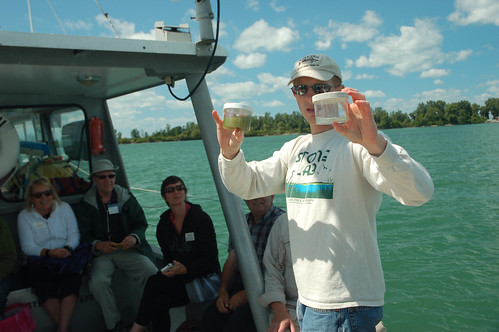
Michigan farmers heard firsthand from experts about the water quality issues facing Lake Erie as well as the importance of conservation work to cleaning water.
A group of 40 farmers from southeast Michigan visited Ohio State University’s Stone Laboratory on Gibraltar Island in Lake Erie. The tour was held in late summer, not long after 500,000 people in the Toledo area were forced to spend days without public drinking water.
Toledo’s water supply was determined unsafe because of the presence of microcystin, which is produced by algae blooms caused by phosphorus loading to the lake. Large amounts of nutrients like phosphorous cause algae to grow rapidly; when it dies, it removes oxygen from the water, posing threats to water quality. Toledo draws its drinking water from the part of Lake Erie where large algae blooms have formed in recent years.
Amy Gilhouse, a technician with the Michigan Agriculture Environmental Assurance Program, coordinated the tour. MAEAP is a voluntary program created by governmental and agricultural organizations that allows farmers to certify that their operations incorporate sound environmental practices.
The National Fish and Wildlife Foundation and the Michigan Farm Bureau helped fund the tour, and USDA’s Natural Resources Conservation Service (NRCS) provided support by sending a local conservationist to share information about available programs.
“Taking people out on Lake Erie to fish was my dad’s passion,” said Gilhouse, who grew up in a family of fisherman. “My mother was one of the first women with a fishing charter captain’s license on the Great Lakes.”
A clean lake is critical for vibrant fisheries, she said. On the tour, farmers not only heard from Kendrick Flowers, a district conservationist with NRCS, but from Jeffrey Reutter, the laboratory’s director, as well. Phosphorous has been a problem in the lake for years, he said.
Reutter said environmental efforts reduced the amount of phosphorus entering the lake by two-thirds, primarily through improved sewage treatment. At the time, most of the phosphorus entering the lake was believed to come from sewage.
Now, fertilizer runoff is one of the main contributors of phosphorus to the lake that triggers algae blooms, he said.
One of the farmers attending the tour was Jerry Heck. Heck farms 700 acres of corn, soybeans and wheat and his field drains go directly to Lake Erie.
He has installed filters strips, practices no-till on most of his land and recently installed water control structures on his field tile outlets utilizing financial assistance from NRCS. Heck also does soil testing and uses variable rate application to reduce his use of fertilizers and lime.
“Even though we’ve been studying Lake Erie for 40 years, there’s a lot we still don’t understand,” Heck said.
Reutter said more research is needed as well as more conservation work needs to be adopted.
“Municipalities, industry and agriculture are all being encouraged to reduce impacts by 40 percent,” Gilhouse said. “Michigan farmers are taking action by moving their farms to MAEAP verification and implementing more conservation practices.”
Just recently, NRCS made available $2 million for farmers in Ohio wanting to plant cover crops, one of the main conservation practices that will help prevent runoff.
Over the past five years, USDA has worked with landowners, community leaders and members of Congress to invest about $46 million targeted to restore and protect the Great Lakes. Just this year, Agriculture Secretary Tom Vilsack designated the Great Lakes Basin as a critical conservation area, or CCA, in the new 2014 Farm Bill Regional Conservation Partnership Program, which will invest an additional $1.2 billion through conservation partnership projects to improve water quality and quantity.


